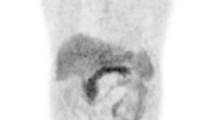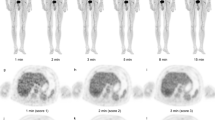Abstract
Positron emission tomography (PET) has now gained a place in the management of patients with cancer, including those with Hodgkin's disease and non-Hodgkin's lymphoma. Restaging studies and those addressing the monitoring of response to treatment are especially in focus. Most of the knowledge gained has been achieved with dedicated BGO-based PET technology, but there are a number of developments that will impact on the use of this metabolic imaging technique in the investigation of patients with lymphoma. The challenges ahead are determined by the need for high-quality whole-body imaging associated with increased patient throughput and the need to investigate the role of new labelled ligands. The latter are likely to yield new insights into tumour cell characterisation, tumour behaviour and tumour outcome assessment. The study of new radiolabelled ligands will impose further demands for rapid dynamic data acquisition and accurate tracer quantification. Current and future developments in PET technology range from the use of new detector materials to different detector geometries and data acquisition modes. The search for alternatives to BGO scintillation materials for PET has led to the development of PET instruments utilising new crystals such as LSO and GSO. The use of these new detectors and the increased sensitivity achieved with 3D data acquisitions represent the most significant current developments in the field. With the increasing demands imposed on the clinical utilisation of PET, issues such as study cost and patient throughput will emerge as significant future factors. As a consequence, low-cost units are being offered by the manufacturers through the utilisation of gamma camera-based SPET systems for PET coincidence imaging. Unfortunately, clinical studies in lymphoma and other cancers have already demonstrated the limitations of this technology, with 20% of lesions <15 mm in size escaping detection. On the other hand, the recent development of combined PET/CT devices attempts to address the lack of anatomical information inherent with PET images, taking advantage of further improvement in patient throughput and hence cost-effectiveness. Preliminary studies using this multimodality imaging approach have already demonstrated the potential of the technique. Although the potential exists, certain technical issues with PET/CT require refinement of the methodology. Such issues include organ movement (such as respiratory motion), which strongly influences the image fusion of a rapidly acquired CT scan with the slower acquisition of a PET dataset, and the derivation of CT-based attenuation coefficients in the presence of contrast agents or metallic implants. The application of the technology for radiotherapy planning also poses a number of associated challenges. Finally, the development of dedicated PET systems based on planar detector arrangements with new detector components has the potential to improve clinical throughput by over 100%, but clinical trials using such systems have still to be carried out in order to establish the associated whole-body image quality.






Similar content being viewed by others
References
Bomanji JB, Costa DC, Ell PJ. Clinical role of positron emission tomography in oncology. Lancet Oncol 2001; 3:157–164.
Czernin J, Phelps ME. Positron emission tomography scanning: current and future applications. Ann Rev Med 2002; 53:89–112.
Bendini M, Zuiani C, Bazzocchi M, Dalpiaz G, Zaja F, Englaro E. Magnetic resonance imaging and Ga-67 scan versus computed tomography in the staging and in the monitoring of mediastinal malignant lymphoma: a prospective pilot study. MAGMA 1996; 4:213–224.
Paul R. Comparison of F-18 2-fluorodeoxyglucose and gallium-67 citrate imaging for detection of lymphoma. J Nucl Med 1987; 28:288–292.
Kostakoglu L, Leonard JP, Kuji I, Coleman M, Vallabhajosula S, Goldsmith SJ. Comparison of fluorine 18 fluorodeoxyglucose positron emission tomography and Ga67 scintigraphy in evaluation of lymphoma. Cancer 2002; 15:879–888.
Naumann R, Vaic A, Beuthien–Baumann B, Bredow J, Kropp J, Kittner T, Franke WG, Ehninger G. Prognostic value of positron emission tomography in the evaluation of post treatment residual mass in patients with Hodgkin's disease and non Hodgkin's lymphoma. Br J Haematol 2001; 115:793–800.
Becherer G, Potzi C, Raderer M, Dudczak R, Kletter K. Positron emission tomography with F18 2 fluorod2-deoxyglucose (FDG-PET) predicts relapse of malignant lymphoma after high dose therapy with stem cell transplantation. Leukemia 2002; 16:260–267.
Intercollegiate Standing Committee on Nuclear Medicine. Position paper on a strategy for the provision of PET in the UK. 2002.
Phelps ME, Hoffman EJ, Huang SC, et al. ECAT: a new computerized tomographic imaging system for positron emitting radiopharmaceuticals. J Nucl Med 1978; 19:635–647.
Spinks TJ, Guzzardi R, Bellina CR, et al. Performance characteristics of a whole body positron tomography. J Nucl Med 1988; 29:1833–1841.
Adam LE, Zaers J, Ostertag H, et al. Performance evaluation of the whole body PET scanner ECAT EXACT HR+ according to the IEC protocol. IEEE Trans Nucl Sci 1997; 44:1172–1179.
Lewellen TK, Kohlmyer SG, Miyaoka MS, Kaplan MS. Stearns CW, Schubert SF. Investigation of the performance of the GE ADVANCE positron emission tomograph in 3D mode. IEEE Trans Nucl Sci 1994; 43:2199–2206.
Melcher CL, Schweitzer JS. Cerium-doped lutetium oxyorthosilicate: a fast, efficient new scintillator. IEEE Trans Nucl Sci 1992; 39:502–505.
Takagi K, Fukazawa T. Cerium-activated Gd2SiO5 single crystal scintillator. Appl Phys Lett 1983; 42:43–45.
Nutt R, Karp JS. Controversies: Is LSO the future of PET? (For and Against). Eur J Nuc Med 2002; 29:1523–1525.
van Eijk CWE. Inorganic scintillators in medical imaging. Phys Med Biol 2002; 47:R85–R106.
Stearns CW. Scatter correction method for 3D PET using 2D fitted Gaussian functions. J Nucl Med 1995; 36:105.
Ollinger JM. Model based scatter correction for fully 3D PET. Phys Med Biol 1996; 41:153–176.
Watson CC, Newport D, Casey ME. A single scatter simulation technique for scatter correction in 3D PET. In: Grangeat P, Amans JL, eds. Fully three dimensional image reconstruction in radiology and nuclear medicine. London: Kluwer Academic, 1996.
Daube-Witherspoon ME, Green SL, Bacharach SL, et al. Influence of activity outside the field of view on 3D PET imaging. J Nucl Med 1995; 36s:184P.
Weber WA, Ziegler SI, Thodmann R, Hanauske AR, Schwaiger M. Reproducibility of metabolic measurements in malignant tumors using FDG PET. J Nucl Med 1999; 40:1771–1777.
Lewellen TK, Miyaoka RS, Jansen F, Kaplan MS. A data acquisition system for coincidence imaging using a conventional dual head gamma camera. IEEE Trans Nucl Sci 1997; 44:1214–1218.
Muehllehner G, Ceagan M, Countryman P, Nellemann P. SPECT scanner with PET coincidence capability. J Nucl Med 1995; 36:175P.
Boren EL, Delbeke D, Patton JA, et al. Comparison of FDG PET and positron coincidence detection imaging using a dual-head gamma camera with 5/8-inch NaI(Tl) crystals in patients with suspected body malignancies. Eur J Nucl Med 1999; 26:379–387.
Delbeke D, Patton JA, Martin WH, et al. FDG PET and dual-head gamma camera positron coincidence detection imaging of suspected malignancies and brain disorders. J Nucl Med 1999; 40:110–117.
Landoni C, Gianolli L, Lucignani G, et al. Comparison of dual-head coincidence PET versus ring PET in tumour patients. J Nucl Med 1999; 40:1617–1622.
Shreve PD, Steventon RS, Deters EC et al. Oncologic diagnosis with 2-[fluorine-18]fluoro-2-deoxy-d-glucose imaging: dual-head coincidence gamma camera versus positron emission tomographic scanner. Radiology 1998; 207:431–437.
Tatsumi M, Yutani K, Watanabe Y, et al. Feasibility of fluorodeoxyglucose dual-head gamma camera coincidence imaging in the evaluation of lung cancer: comparison with FDG PET. J Nucl Med 1999; 40:566–573.
Weber W, Young C, Abdel-Dayem HM, et al. Assessment of pulmonary lesions with18F-fluorodeoxyglucose positron imaging using coincidence mode gamma cameras. J Nucl Med 1999; 40:574–578.
Zimny M, Kaiser HJ, Cremerius U, et al. Dual-head gamma camera 2-[fluorine-18]-fluoro-2-deoxy-d-glucose positron emission tomography in oncological patients: effects of non-uniform attenuation correction on lesion detection. Eur J Nucl Med 1999; 26:818–823.
Visvikis D, Fryer T, Downey S. Optimisation of noise equivalent count rates for brain and body FDG imaging using gamma camera PET. IEEE Trans Nucl Sci 1999; 46:624–630.
Hwang K, Park C, Kim H, Kim H, Yoon S, Pai M, Kim S. Imaging of malignant lymphomas with F-18 FDG coincidence detection positron emission tomography. Clin Nucl Med 2000; 25:789–795.
Old S, Balan K, Parry-Jones C, Marcus R. Gamma camera positron emission tomography in lymphoma. J Nucl Med 1999; 40:62P.
Ak I, Blokland J, Pauwels EKJ, Stokkel MP. The clinical value of F18-FDG detection with a dual head coincidence camera: a review. Eur J Nucl Med 2001; 28:763–778.
Pietrzyk U, Herholz K, Heiss WD. Three dimensional alignment of functional and morphological tomograms. J Comput Assist Tomogr 1990; 14:51–59.
Wahl RL, Quint LE, Cieslak RD, Aisen AM, Koeppe RA, Meyer CR. 'Anatometabolic' tumour imaging: fusion of FDG PET with CT or MRI to localize foci of increased activity. J Nucl Med 1993; 34:1190–1197.
Turkington TG, Jaszcak PJ, Pelizzari CA, Harris CC, Macfall JR, Hoffman JM, Coleman RE. Accuracy of registration of PET, SPECT and MR images of a brain phantom. J Nucl Med 1993; 34:1587–1594.
Tai YC, Lin KP, Hoh CK, Huang H, Hoffman EJ. Utilisation of 3D elastic transformation in the registration of chest X-ray CT and whole body PET. IEEE Trans Nucl Sci 1997; 44:1167–1171.
Rueckert D, Sonoda L, Hayes C, Hill DLG, Leach M, Hawkes DJ. Non-rigid registration using freeform deformations: application to breast MR images. IEEE Trans Med Imaging 1999; 18:712–721.
Beyer T, Townsend DW, Blodgett TM. Dual modality PET/CT tomography for clinical oncology. Q J Nucl Med 2002; 46:24–34.
Kinahan PE, Townsend DW, Beyer T, Sashin D. Attenuation correction for a combined 3D PET/CT scanner. Med Phys 1998; 25:2046–2053.
Visvikis D, Costa DC, Croasdale I, Lonn AHR, Bomanji J, Gacinovic S, Ell PJ. CT-based attenuation correction in the calculation of semi-quantitative indices of [18F]FDG uptake in PET. Eur J Nucl Med Mol Imaging 2003; 30:344–353.
Goerres GW, Hany TF, Kamel E, von Schulthess GK, Buck A. Head and neck imaging with PET and PET/CT: artefacts from dental metallic implants. Eur J Nucl Med Mol Imaging 2002; 29:367–370.
Goerres GW, Kamel E, Heidelberg TNH, Schwitter MR, Burger C, von Schulthess GK. PET-CT image coregistration in the thorax: influence of respiration. Eur J Nuc Med Mol Imaging 2002; 29:351–360.
Visvikis D, Cheze-Le Rest, Costa DC, Bomanji J, Gacinovic S, Ell PJ. Influence of OSEM and segmented attenuation correction in the calculation of standardised uptake values for18F-FDG PET. Eur J Nucl Med 2001; 28:1326–1335.
Freudenberg LS, Antoch G, Mueller SP, Stattaus J, Eberhardt W, Debatin J, Bockisch A. Preliminary results of whole body FDG-PET/CT in lymphoma. J Nucl Med 2002; 43:S0P.
Nehmeh SA, Erdi YE, Ling CC, Rosenzweig KE, Squire OD, Braban LE, Ford E, Sidhu K, Mageras GS, Larson SM, Humm JL. Effect of respiratory gating on reducing lung motion artefacts in PET imaging of lung cancer. Med Phys 2002; 29:366–371.
Nahmias C, Nutt R, Hichwa RD, Czernin J, Melcher C, Schmand M, Eriksson L, Andreaco M, Casey M, Moyers C, Michel C, Bruckbauer T, Conti M, Hamill J, Bendriem B. PET tomograph designed for five minute routine whole body studies. J Nucl Med 2002; 43:S11P.
Chatziioannou A. Molecular imaging of small animals with dedicated PET tomographs. Eur J Nucl Med 2002; 29:98–114.
Shao Y, Cherry SR, Farahani K, Meadors K, Siegel S, Silverman RW, Marsden PK. Simultaneous PET and MR imaging. Phys Med Biol 1997; 42:1965–1970.
Slates RB, Farahani K, Shao Y, Marsden PK, Taylor J, Summers PE, Williams S, Beech J, Cherry SR. A study of artefacts in simultaneous PET and MR imaging using a prototype MR compatible PET scanner. Phys Med Biol 1999; 44:2015–2027.
Klose T, Leidl R, Buchmann I, Brambs H, Reske SN. Primary staging of lymphomas: cost effectiveness of FDG PET versus computed tomography. Eur J Nucl Med 2000; 27:1457–1464.
Author information
Authors and Affiliations
Corresponding author
Rights and permissions
About this article
Cite this article
Visvikis, D., Ell, P.J. Impact of technology on the utilisation of positron emission tomography in lymphoma: current and future perspectives. Eur J Nucl Med Mol Imaging 30 (Suppl 1), S106–S116 (2003). https://doi.org/10.1007/s00259-003-1168-3
Published:
Issue Date:
DOI: https://doi.org/10.1007/s00259-003-1168-3




